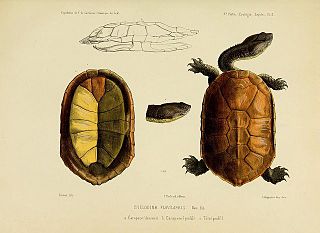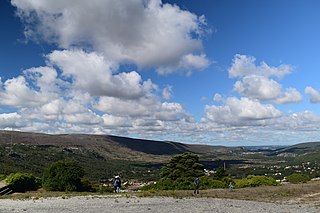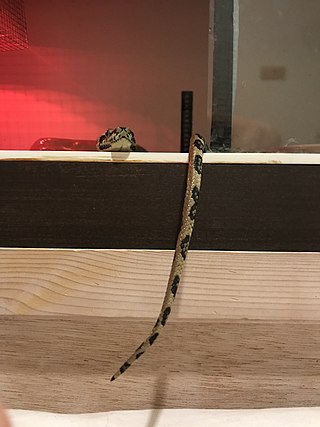
Eagle is the common name for many large birds of prey of the family Accipitridae. Eagles belong to several groups of genera, some of which are closely related. Most of the 68 species of eagles are from Eurasia and Africa. Outside this area, just 14 species can be found—2 in North America, 9 in Central and South America, and 3 in Australia.

Cobra is the common name of various snakes, most of which belong to the genus Naja.

Garter snake is a common name for generally harmless, small to medium-sized snakes belonging to the genus Thamnophis in the family Colubridae. Native to North and Central America, species in the genus Thamnophis can be found from the subarctic plains of Canada to Costa Rica.
François Marie Daudin was a French zoologist.

The Leptotyphlopidae are a family of snakes found in North America, South America, Africa and Asia. All are fossorial and adapted to burrowing, feeding on ants and termites. Two subfamilies are recognized.

Tiger snakes are a large and highly venomous snake of southern Australia, including its coastal islands and Tasmania. These snakes are often observed and locally well known by their banding, black and yellow like a tiger, although the species can be highly variable in coloration and patterning. All populations are classified within the genus Notechis (Elapidae). Their diverse characteristics have been classified either as distinct species or by subspecies and regional variation.

Trigonosaurus, is a genus of saltasaurid dinosaurs from the Maastrichtian Serra da Galga Formation of Brazil. The type species, Trigonosaurus pricei, was first described by Campos, Kellner, Bertini, and Santucci in 2005. It was based on two specimens, both consisting mainly of vertebrae. The two specimens were believed to have come from the same individual. However, one specimen was described as the holotype of Caieiria in 2022. Before its description, it was known as the "Peirópolis titanosaur", after the place it was found.

Xenodontinae is a subfamily of snakes in the family Colubridae.
Dixon's ground snake is a species of snake in the family Colubridae. The species is endemic to Southeastern Brazil.

The Brazilian snake-necked turtle, locally known as cágado da serra, and also commonly known as Maximilian's snake-necked turtle, is a species of turtle in the family Chelidae. The species is endemic to southeastern Brazil. It is one of the smallest Brazilian freshwater turtles reaching a maximum straight carapace length of 20 cm (7.9 in). The species prefers streams with sandy and rocky bottoms and clear water in forests above 600 m (2,000 ft) elevation.

Hydromedusa is a turtle genus in the family Chelidae, commonly known as the South American snake-necked turtles. They are quite closely related to the South American side-necked swamp turtles (Acanthochelys) and the snake-necked turtles of the Australian-Melanesian region (Chelodina), but less closely to the spine-necked river turtles of South America (Podocnemididae) which belong to a more modern lineage of Pleurodira.

Serras de Aire e Candeeiros Natural Park (PNSAC) is a natural park in central west Portugal. It occupies an area of 383.9 km2 (148.2 sq mi) and is the most important repository of limestone formations in Portugal with a variety of geological formations associated with karst topography such as caves, sinkholes, uvalas, poljes, limestone pavements, ponors, among others. It was made a protected area in 1979 with the intend to protect the existing natural aspects and the architectonic and cultural heritage linked to the local populations.

Serra da Bocaina National Park is a national park of Brazil. It is located at the border between the states of Rio de Janeiro and São Paulo in southeastern Brazil.

Caudal luring is a form of aggressive mimicry characterized by the waving or wriggling of the predator's tail to attract prey. This movement attracts small animals who mistake the tail for a small worm or other small animal. When the animal approaches to prey on the worm-like tail, the predator will strike. This behavior has been recorded in snakes, sharks, and eels.

The Hedgehog and the Fox is a late Minimalist sculpture of Richard Serra, installed between Peyton and Fine halls and the football stadium at Princeton University in 2000. It was commissioned for the university by Princeton graduate Peter Joseph in honour of his children some years before his death in 1998.

Caieiria is a genus of titanosaurian dinosaur from the Late Cretaceous Serra da Galga Formation of Brazil. The type and only species is Caieiria allocaudata.

Tropidodryas serra, the Serra snake, is a species of snake in the family, Colubridae. It is found in Brazil.

Tropidodryas striaticeps is a species of snake in the family, Colubridae. It is found in Brazil.
















